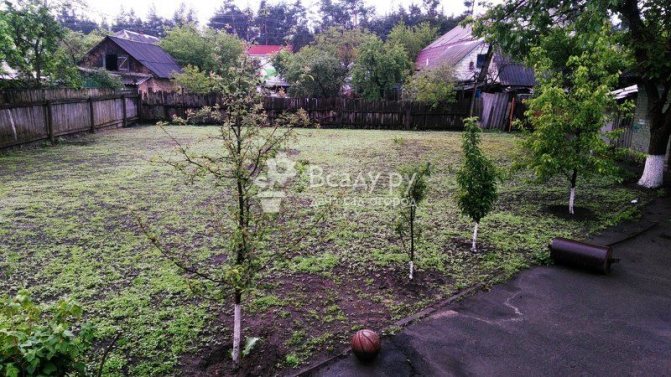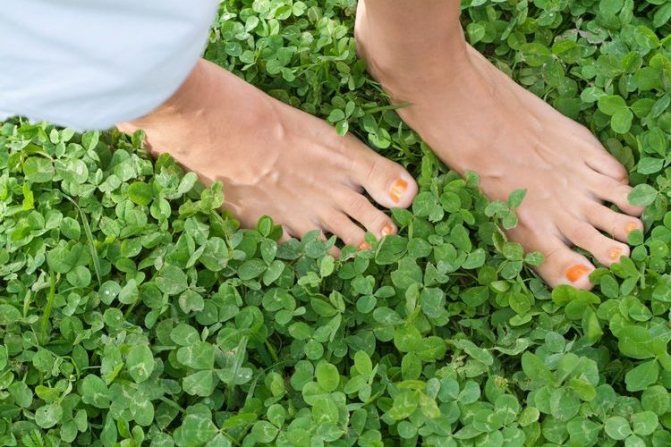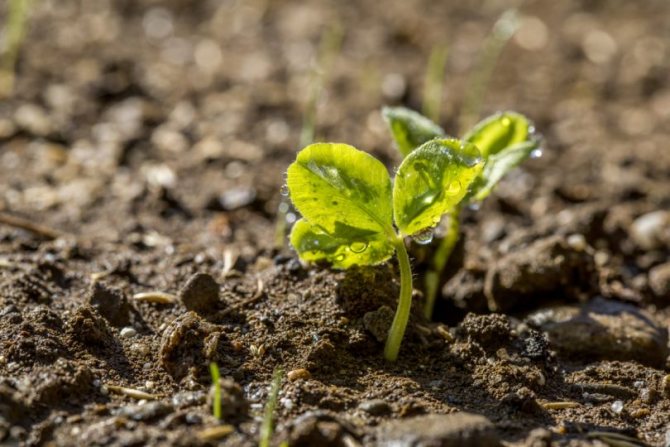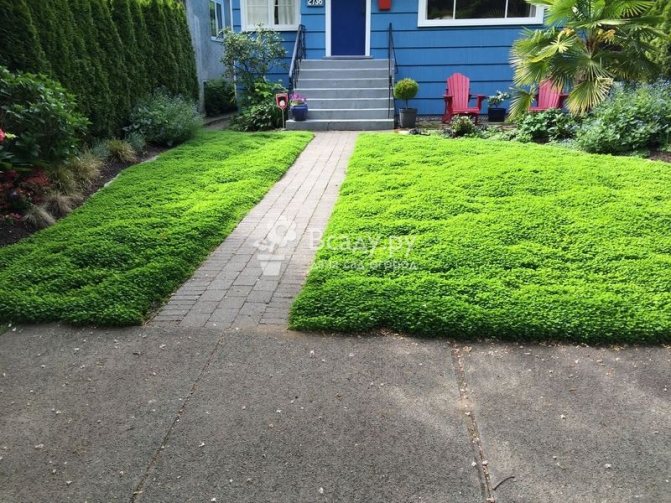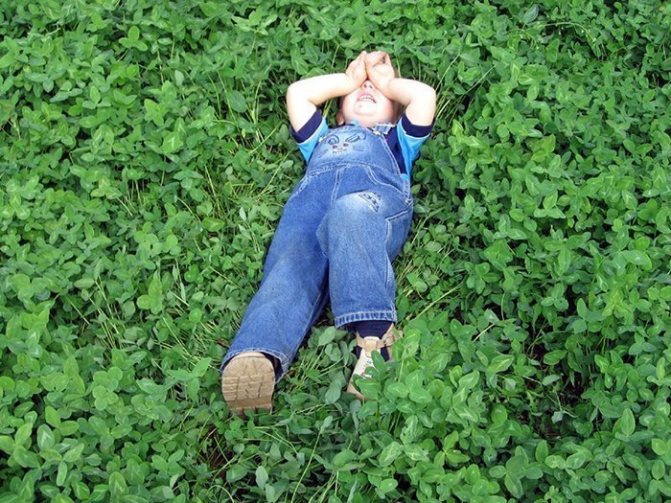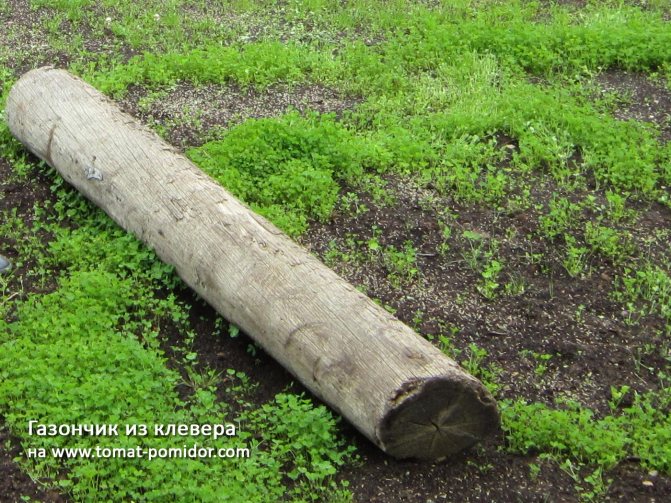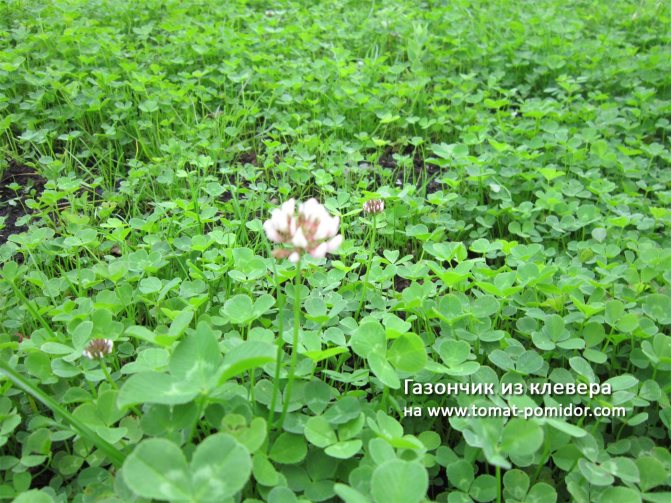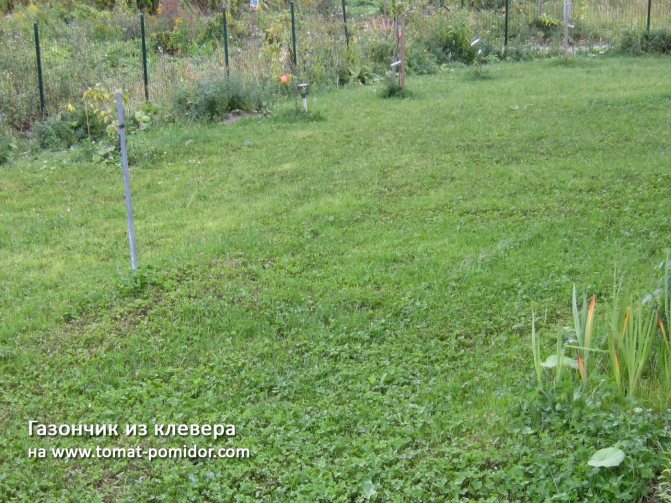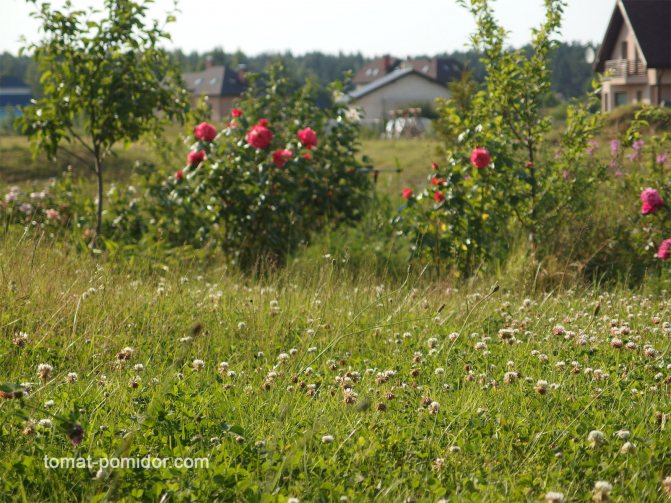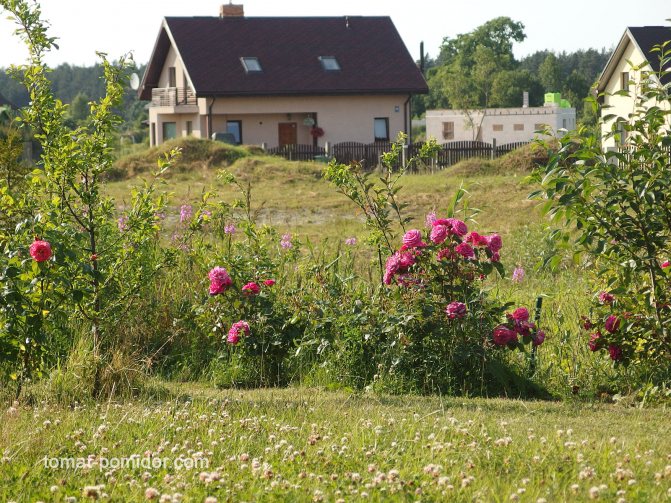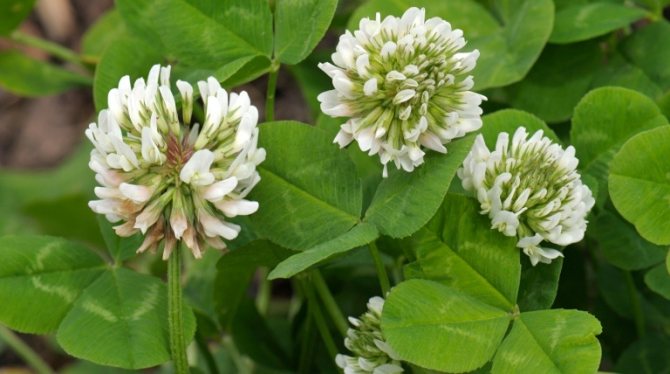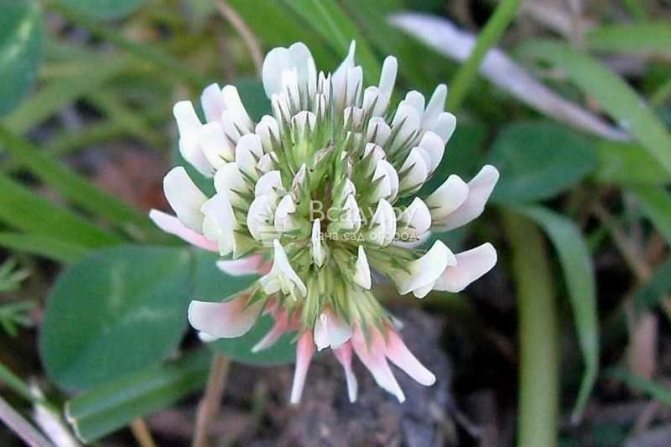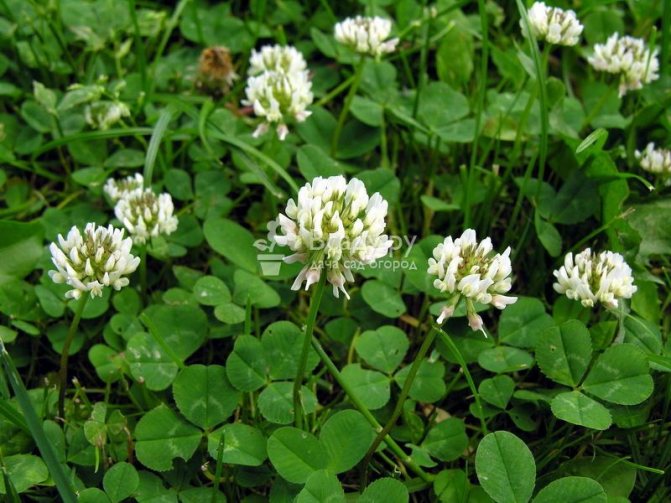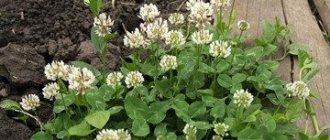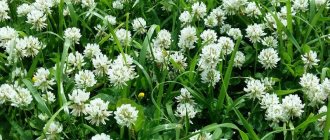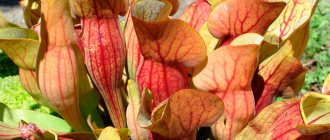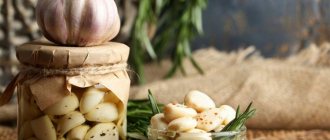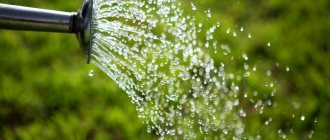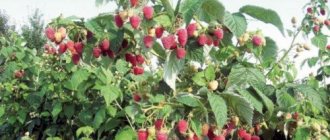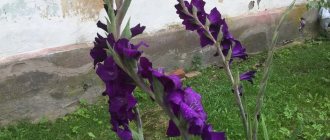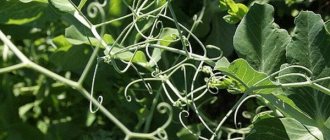Clover, popularly called the shamrock, is a perennial plant in the legume family. The plant is presented in the form of three emerald-colored leaves with a small spherical flower. If you adhere to the correct technology for planting it, as well as take care of it later, then a blooming lawn will delight you every year with an even and soft carpet. To do everything right, consider the detailed instructions: how to plant white clover for the lawn? Simple tips and some nuances from specialists will allow you to get a green carpet as a result of the work done.
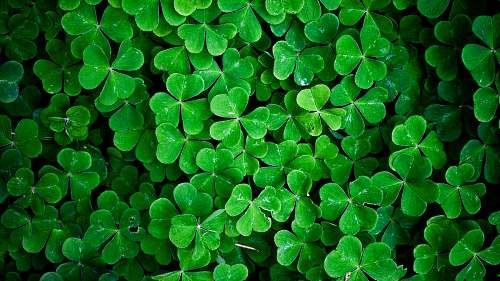
Minuses
Clover lawn also has disadvantages:
- The territory looks attractive only during flowering, because then the inflorescences-balls, like beads, are scattered over the carpet. But after that, the dried flowers make it look not quite beautiful, even untidy. It will be necessary to remove dried inflorescences.
- The lawn grows quickly, and therefore if the plant is in the grass mixture, then after a while it will dominate over others.
- Clovers have damp turf, which makes the coating slippery. It will be unsafe to play on it.
Experts advise purchasing white clover for the lawn at the initial stages of building a house. Reviews indicate that it will not allow weeds to grow. In addition, this allows the soil to be fertilized with nitrogen, which is necessary for the subsequent planting of cultivated plants. Such an update of the site will be required when engaging in beekeeping. Only then will it be impossible to walk on this territory.
How to use clover as a lawn
Clover works well as a lawn in areas that have poorly drained soil, in shaded areas, and if you want to have a beautifully manicured lawn without spending a lot of effort.
Clover keeps weeds out of your lawn. He won't need a haircut. Clover lawn looks no worse than the classic one. Different varieties of clover are used for lawns. The most common are Pink Clover and Creeping Clover (white). Sowing a clover lawn Having decided to make a clover lawn, you must first purchase seeds. This is done in the spring. Clover lawns can be planted earlier than usual, as soon as the ground has thawed after winter, and at night the frosts have stopped. Clover is a hardy plant. It can adapt to different regions and weather conditions. It tolerates frost well and for three years it germinates every year without requiring new sowing. Before planting, you need to level the area with a rake. But you don't have to try as you would with planting a regular grass lawn. Clover will mask all the irregularities in the soil. Then clover seeds must be soaked for an hour in water or a weak solution of potassium permanganate, dried and mixed in half with dry sand or garden soil. In terms of quantity, you need about 100 g of seeds per 1 m² of the future lawn. The seeds mixed with sand are evenly distributed over the lawn area. It is better to sow in several directions - along, then across or diagonally. Crops from above are covered with a layer of earth of one centimeter. There is no need for fertile soil or peat for the top layer - clover will germinate on any soil.The ground is slightly compacted (there is no need to roll up the entire area either, it is enough to walk on the sown area, placing a sheet of plywood under your feet). Care After the soil is compacted, the crops should be watered with a very light rain so that the soil does not erode and wash away the seeds. Try to plant when no rain is forecast for at least a couple of days. Water the lawn daily, trying to keep the soil moist all the time and not letting it dry out for a week. In two weeks, sprouts will appear. Your new clover lawn has begun to form. Clover is quite drought tolerant - an adult lawn can be watered no more than once a week in the summer. There is no need to fertilize the lawn from clover - the plant contains enough nitrogen to not only grow and turn green, but also to saturate the soil with useful substances. The disadvantage of the lawn is that it is not resistant to trampling. To maintain the appearance of a beautiful green lawn, it is necessary to lay paths in the lawn. After three years, the lawn will have to be sown again using the above method.
Planting a clover lawn
Unfortunately, it is impossible to order a rolled lawn from clover because of the too powerful root system. Therefore, clover lawns can only be obtained by sowing. Preparing the soil for laying a clover lawn is carried out in the same way as for a conventional grass mixture: you need to dig up the area, remove the roots of perennial weeds from the soil, roll the surface with a roller to compact the soil layer and level the surface (read the details in our special article).
The white clover lawn does not tolerate the increased acidity of the soil, in this case it is necessary to deoxidize it - add lime or dolomite flour.
If the site is heavily infested with dandelions and other weeds, then before digging it is advisable to treat it with continuous herbicide preparations, for example, Roundup.
Clover seeds are very small, so you shouldn't sow it in windy weather. The seeding rate is 2.5-3 kg per one hundred square meters. Sowing of clover is carried out randomly with an overlap, but not thickening: clover grows quickly, it needs free space for this.
The main condition for friendly seedlings is good pre-sowing watering of the soil and shallow seeding. On heavy soils, seeds are sealed no deeper than 0.5 cm, on light soils - no deeper than 1 cm. You can not close the seeds with a rake, but lightly sprinkle them with a thin layer of sand. For even sowing, the seeds are mixed with sand or raw sawdust.
In order not to spread the seeds on your feet throughout the site, plastic bags are put on the shoes. If there is no rain for a long time after sowing, plantings should be watered with a fine spray.
At an air temperature of 18-20 degrees, seedlings appear in 5-6 days, at a temperature of 14-16 degrees - in 6-8 days.
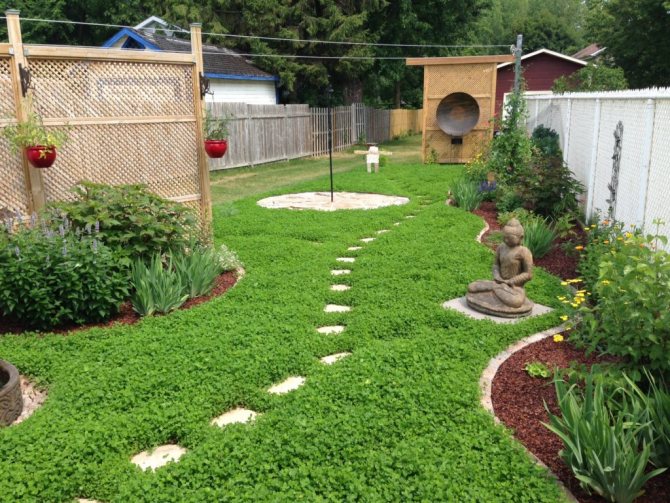

Clover lawn - an alternative to traditional
Diseases and pests
When waterlogged, clover suffers from the development of a fungus, most often the following diseases occur:
- fusarium (fungi from the genus Fusarium Link);
- rust (causative agent - fungus Uromyces trifolii-repentis Liro);
- anthracnose (mushroom Aureobasidium pullulans);
- ascochytosis (Ascochyta trifolii Bond mushroom);
- brown spot of clover (marsupial mushroom Pseudopeziza trifolii Fckl).
The fight against fungal diseases consists in treatment with a 1% solution of colloidal sulfur. Sprayed twice: when the first signs of the disease appear and then after 8-10 days.
Pollination with ground sulfur or fluff lime is also used. Clover can also be affected by the parasitic flowering plant dodder. It is devoid of leaves and roots and exists only at the expense of the host plant.
If clover is used for livestock feed, active measures must be taken to eliminate the dodder, as it is poisonous and can even kill animals.
Hay with the presence of such grass quickly grows moldy, therefore, after mowing, the clover is cleaned of the parasite.And even in this case, give the animals with caution - with a break of 10-15 days.
When a dodder is found, it is important to mow the clover before the parasite begins to bloom. Mowing is carried out on an area exceeding the size of the hearth by 1.5 m in each direction. The cut grass is burned outside the lawn. Another pest is a cyst nematode.
Cons and pros
Before planting a clover on your site, you should consider all the advantages and disadvantages of this plant. In addition to being unpretentious, it has the following advantages:
- Clover lawn is resistant to trampling and grows quickly.
- Clover - a honey plant will attract bees from all over the area, this will increase the pollination of fruit trees. Walking barefoot in the green is not recommended. Insects can sting.
- Clover saturates the soil with nitrogen, perfectly prepares it for the subsequent planting of vegetables and trees.
- Aesthetic appearance.
- But the disadvantages that a clover lawn has can be reflected in the choice not in his favor.
- Due to the dense clover turf, the soil underneath it does not dry out, so the lawn can be slippery.
- Good proliferation of clover will seem like a real disaster when you want to get rid of it.
- After mowing, brown petioles and leaves remain visible on the lawn for several days. It will look unkempt until new greens grow.
Attention! Clover is considered a perennial plant, but despite this, it is recommended to re-sow it after 3-4 years.
Gardeners about white clover
- Clover bean green manure. Clover belongs to the legume family, it perfectly saturates the soil with nitrogen. Winter-hardy, photophilous, perfectly tolerates waterlogging. Sowed to improve soil structure, forms a dense green carpet.
- Propagated by seeds and shoots. Well adapted to various conditions. The seeds formed after flowering germinate well the next year. In addition to seed propagation, clover throws out shoots, which also take root and take root. Thanks to the shoots, it forms a dense and stable carpet that is resistant to trampling. Weeds do not tolerate this neighborhood and die, so the lawn remains clean and uniform.
- Not picky about leaving. Due to the rather strong root system, clover tolerates dry days well, but is responsive to feeding and timely watering. Recovers quickly after mowing. Blooms from June to September. It is a good honey plant.
Video: The video from Greensad tells how to use herbicides, what it is, what types are there. It is especially interesting that the expert admits that he is an opponent of herbicides. Advises to use drugs only in extreme cases.
Brief description of the culture
Clover grows in Russia in all regions. The meadow plant loves moist soil and does not tolerate dry summers. Therefore, in the southern regions of the country, it is less common in the wild than in the middle lane. Clover grows well even in the Perm region and regions with similar climatic conditions.
Clover is familiar to everyone, without exception. His leaf is assembled from three separate leaves, collected at one point. The flowers of the plant can be painted white, all shades of pink, lilac and crimson flowers.
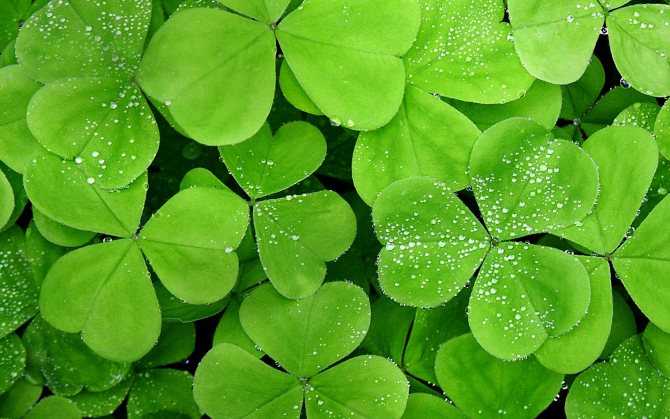

Clover
It is interesting: breeders have developed new, interesting varieties with four leaves.
Clover flowers and leaves have been used by folk medicine for the manufacture of medicinal drugs for many centuries.
Landing technology
As already mentioned, a tenacious plant does not require weeding or feeding. But, if you want to get an even and beautiful thick carpet, you should consider a few recommendations. So, among the preparatory work, you should correctly determine the place. The best option is a sunny lawn or partial shade.Seeds are purchased in a specialized shop of gardeners and gardeners: about 300 grains are used for 1 m 2. Planting is recommended in spring or early summer.
- As in the case of a regular lawn, in order for the seeds to take root well and quickly, remove the top layer of soil (up to 5 cm) and level the area.
- Fast sprouting will provide a simple soak for 1 hour before direct sowing. Also, the seeds can be mixed with a small part of the soil, and then scattered evenly over the area.
- To prevent the birds from eating the grains, a thin layer of soil (about 1 cm) is poured on top.
- It is recommended to use the fine rain nozzle for watering, as the strong pressure will wash away the white clover seeds or flood them. Soil moisture should be kept for 7-10 days. The possibility of walking on the lawn is excluded. Shoots should appear in 15 days.
Important! Clover grows well in an area where cereals were previously grown.
Care
Seedling care.
In the first year, the clover lawn is not very decorative and does not bloom. Its main enemies are weeds. If the area was not treated with Roundup before laying the lawn, then regular manual weeding or spot treatment of weeds with herbicides (applied to the plant with a paint brush) is necessary. On germination, clover can be treated with Lemur, Bazagran, Agritox, Agristar preparations.
For spring planting, mowing the lawn in the first year is not required, but regular watering is necessary.
In the second year, the clover grows well, filling almost all the voids, its root system is strengthened, the plant begins to bloom. When you reach a height of 10 cm, it is recommended to cut for the first time.
After cutting, there are often sticking out stems of the plant, but after a couple of days new young leaves appear and the clover lawn takes on a beautiful appearance again.
The mowing frequency depends on the purpose of the lawn. If the lawn is functional, then it should be mowed more often, since the flowering heads attract bumblebees and bees, the risk of being stung increases. If clover plantings perform exclusively decorative functions, then they can be cut less often, as the inflorescences begin to dry out and turn brown. After shearing, the plants grow back quickly and begin to bloom again.
The lawn looks neater when mowed with a lawn mower. But if the clover has grown too much, its juicy stems can jam the knives, especially low-powered electric lawn mowers suffer from this. The optimum height for a clover lawn is 6 cm.
Clover lawn care after winter.
In the spring, you can find a partial loss of plants. Most often this happens if the variety is not sufficiently winter-hardy for the growing region.
Small bald patches may not be repaired, since creeping clover grows very quickly. If there are a lot of voids, then it is necessary to sow seeds in these places. Sow superficially, sprinkling with a small layer of earth and sand.


Microclover
Plant care
Clover, like a wild-growing herb, feels great without leaving. But in order for the lawn to look attractive, you still need to do something.
Watering
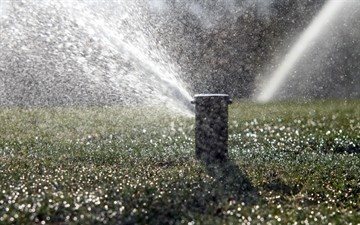

If the weather is not dry, the clover completely manages the rain moisture. Therefore, watering is usually required relatively rarely - once every 7 days or generally from case to case. In drought, water is supplied more often.
Clover, especially red clover, does not like stagnant water - in such conditions it is affected by a fungus, therefore it is required:
- choose places for planting clover where flooding does not occur;
- level the area before planting the seeds: if it is bumpy, water accumulates in the lowlands;
- on heavy clay soil: lay a crushed stone and sand drainage pad under the fertile layer.
Water should be supplied in sufficient quantity, but not in excessive quantity.
Weeding and removing dried flowers
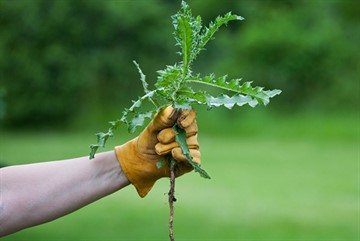

Allowed only by hand: clover does not tolerate chemical treatment. It is important to uproot perennial weeds, otherwise they will germinate again soon. It is best to do this after rain, when the ground is soft.
They stay on the stem and make the lawn look unattractive and brown.
Clover is a perennial plant; accordingly, it begins to bloom from the second year of life.
A haircut
It is recommended not to run a clover lawn: as already mentioned, high thickets are actively populated by snails and slugs, which bring death to all cultivated plants in the vicinity. It is important to mow the lawn after the first flowering (early summer), thereby removing dead wood. This will give your lawn a neat look and intensify flowering.
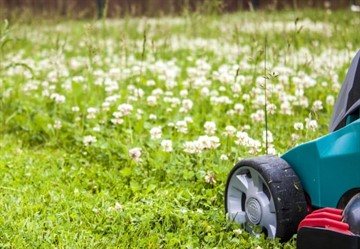

Trimming destroys the color of the weeds, preventing them from multiplying in this way. For clover, which does not allow chemical treatment with herbicides, this is especially important.
Moreover, if the lawn has a large area. Shearing also prevents the spread of the clover itself, which is important for nearby plants with a weak root system.
Useful properties of clover
The healing power of this meadow plant is amazing. It is not for nothing that in folk medicine medicinal infusions and decoctions from clover are widely used, it contains a huge amount of vitamins of various groups, minerals, carotene, flavonoids, salicylic acid. Clover flowers and leaves are antiseptic, anti-inflammatory and diuretic. Also, the plant helps to normalize metabolic processes and increase the body's immunity.
Did you know that clover belongs to the legume family. There are about 250 plant species.
The tea from the collection, which contains dried red clover heads, St. John's wort and black currant leaves, helps to increase lactation in a nursing mother. You need to take dry herbs in a ratio of 1: 1: 2, that is, 1 part of clover and St. John's wort and 2 parts of currant, and brew the collection with boiling water. Let the tea brew and take 3 times a day.
Young clover leaves are used to prepare salads, and aromatic herbal tea is obtained from its inflorescences.
Our grandmothers prepared an excellent anti-aging lotion from clover. Early in the morning, they collected the dew from the flower, pouring it into a container. Then they put a couple of clover stalks in this liquid, and in the evening they washed their face with this wonderful remedy for wrinkles.Before you start taking decoctions and tinctures of clover, you should definitely consult with your doctor. As with any other drug, clover has contraindications. It should not be taken during pregnancy, high blood pressure, obesity, or chronic gastrointestinal disease.
Using clover as a green manure
Despite the fact that the mass of the red clover crop is less than that of lupine, it is popular as a green manure, not less, and perhaps even more.
How to improve yields?
We are constantly receiving letters in which amateur gardeners are worried that due to the cold summer this year there is a poor harvest of potatoes, tomatoes, cucumbers, and other vegetables. Last year we published TIPS on this matter. But unfortunately, many did not listen, but some still applied. Here is a report from our reader, we want to advise plant growth biostimulants that will help increase the yield up to 50-70%.Read ...
Clover as a lawn
Like all members of the legume family, thickenings form on the roots of clover, which accumulate nitrogen from the environment, and then give it to the soil.
When decomposing, the green mass of clover enriches the soil with mineral and organic fertilizers, contributes to the formation of a layer of humus.
The best variety of clover for use as a green manure, namely red, varieties with white and pink flowers have the listed useful qualities to a lesser extent. One of the beneficial properties of red clover compared to other green manure plants is the ability to convert hard-to-absorb phosphorus compounds into readily available ones. The root system of red clover helps to loosen the soil, improves its mechanical composition, and makes it more moisture and air permeable.
In addition to the fact that planting clover fertilizes the soil, they also heal it, as they activate the vital activity of beneficial soil microorganisms.
Pros and cons of clover lawn
Pros of white clover:
- undemanding to care
- resistance to disease and trampling
- cut grass can be used as mulch for other plants or go to feed animals and poultry
Minuses:
- after a haircut it loses its decorative effect for several days
- attracts dangerous insects (bees, bumblebees)
- self-seeding is spread throughout the site
- after rain, due to the large surface of the leaves, it dries for a long time and can be slippery (not suitable for active games)
Clover: varieties and varieties
The plant belongs to the legume family. There are more than 300 types of clover, of which about 70 grow on the territory of the post-Soviet states.
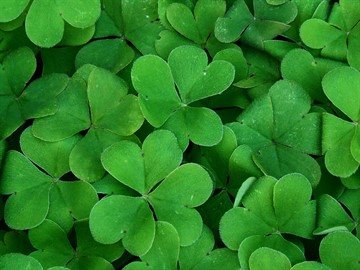

Here are some examples of clover:
- meadow;
- narrow-leaved;
- angular;
- golden;
- mountain;
- Egyptian;
- red;
- pink;
- white.
The last three varieties are the most common. Types of clover differ from each other not only in the color of the flowers, but also, for example, in the structure of the root system.
So, red clover takes root to a depth of 2 m (high resistance to drought and cold), while white - only 35 cm. There are other distinctive features, including the color of the leaves. Before planting, it is recommended to study the list of species and varieties in order to choose the most suitable for your site.
To date, breeders have bred many varieties of white creeping clover, for example:
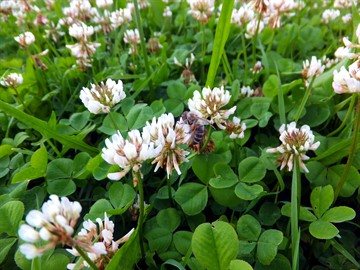

- Rivendel;
- Klondike;
- Sylvester;
- Pipolin;
- Ronnie;
- Volat;
- Dukhmyany.
The last two varieties were bred in Belarus.
Clover is great for growing lawns due to the following qualities:
- aesthetic appeal: dense grass of a juicy green color, blooming twice a year with fragrant and beautiful white buds in the shape of a ball;
- gentle, soft shoots: it is pleasant to walk barefoot on the lawn;
- resistance to trampling: outdoor games on the lawn do no harm to it.
In grass mixtures, clover supports cereals well, especially ryegrass. With such a neighborhood, they grow better and the lawn acquires a rich color.
The popularity of the plant is due to other advantages:
- vitality. Clover grows well on any soil, both in illuminated areas and in moderately shaded areas. It tolerates a lack of moisture and does not need feeding. For a novice gardener, this is the best option;
- dense and strong root system that holds the soil together. This makes the clover suitable for planting in steep slopes;
- low cost. Clover seeds are available for self-picking. Moreover, they have good germination;
- suitability for consumption by pets and poultry;
- the ability to improve the soil. The roots of clover are home to bacteria that enrich the soil with nitrogen. Vegetables planted after clover give a rich harvest.
Disadvantages of clover:
- the plant aggressively displaces all others, spreading rapidly. We have to protect the garden and flowers with a weak root system from clover. The positive side of this property is the ability to displace weeds;
- blooming clover strongly attracts bees and other stinging insects, so the owners of the site need to be careful during this period;
- after rain or watering, the grass becomes slippery. It is not recommended to run on the lawn at this time, and you should walk with caution;
- in a strongly grown form, the grass attracts grape slugs and snails - due to the high humidity in the thickets. Therefore, it is important to mow the lawn in a timely manner;
- after a haircut for several days, until it recovers, it loses its attractive appearance.
Features of white clover
White clover creeping (Latin Trifolium repens) for its decorative appearance during the flowering period received the popular name "White gruel". It is a short, climbing plant with bright leaves and spectacular white flowers. Shoots root well, spread easily over the surface of the soil, cover all bald spots and create a single soft lawn cover.
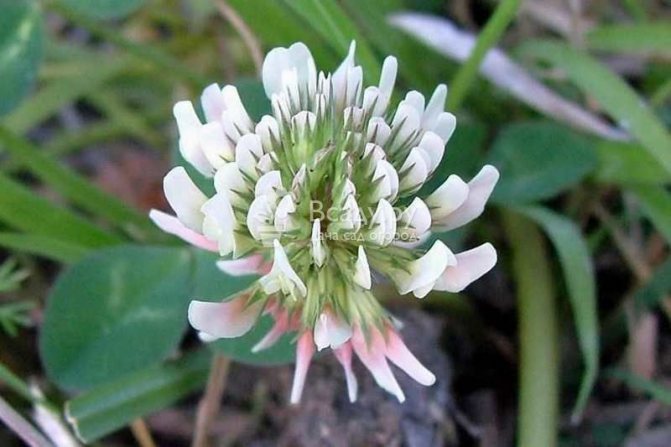

White clover flower
The plant is highly bushy, therefore it is not recommended to use it in the compositions of grass mixtures. When creating turf, it is more effective as a stand-alone crop, but in some cases co-sowing with other climbing grasses is allowed.
Clover lawn is a great way to improve the ecological situation on the site. Root tubers accumulate natural nitrogen, which makes it possible to reduce the dose of applied fertilizers containing this element, or to eliminate them altogether.
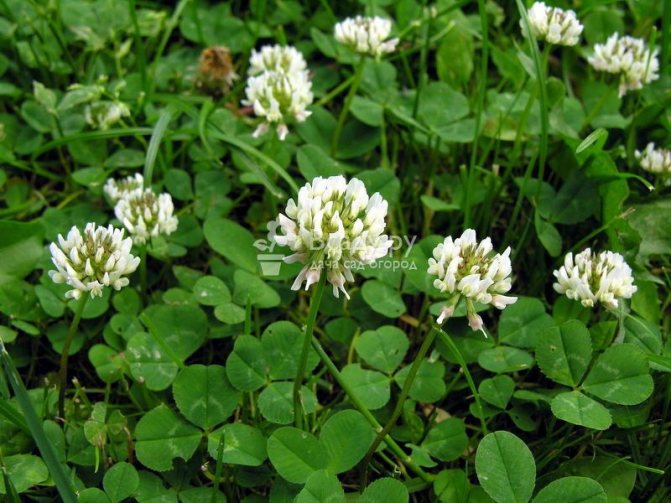

White clover creeping during flowering
The plant has a powerful root system (up to 45 cm), which allows it to be used to strengthen slopes, tinning desert areas. Clover is photophilous, loves moisture, but does not tolerate stagnant water.
When and how to sow clover outdoors: planting and caring for the plant
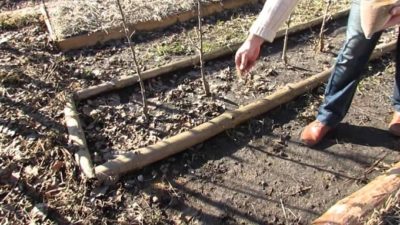

The arrangement of the suburban area is eye-catching. Instead of a classic lawn, you can grow a clover plantation. The natural charm of such a site will be expressed by a thousand flower balls. Moreover, the colors are presented in pink, yellow, red, white. Often, varieties of clover are mixed and instead of just a green lawn, a lively colored carpet is obtained, very tenacious and unpretentious.
Clover agrotechnology
For red clover, humus nutrient soils with low acidity are preferable. The plant does not tolerate saline and sandy soils. The earth should be moderately moist, without stagnation.
Pink clover is not so picky and grows well on structured loamy and sandy loam soils. It tolerates acidic substances more easily than other varieties.
White clover is the most unpretentious, grows calmly on peat bog, alumina, if only there is good drainage and sufficient moisture.
Clover does not belong to drought-resistant crops, cold-hardy, but winter hardiness is low. May also be affected by summer heat. It is considered relatively shade-tolerant.
Site preparation
If the precursors of the trefoil on the site were cereals, this will have a positive effect on growth. It is advisable to grow the grass in spacious areas. Clover will look good in areas of the garden with a small shadow; they can sow empty places near a building, a fence.
Having decided on the location of the lawn, you need to prepare the soil in order to sow clover.
Important! Preparing the soil with a cultivator or Fokin flat cutter is considered the most optimal way.
The selected area must be dug onto the floor with a bayonet, then loosened up the ground and select all the roots of weeds, stones, debris. At the same time, phosphorus and potash fertilizers are applied, the acidic soil is lime.
Important! It is not necessary to apply nitrogen fertilizers under the clover, since it produces nitrogen itself. An overdose will kill the herb.
Before sowing clover on the site, the land must be allowed time to settle. Usually it is 4-5 days.
You should know that it is advisable to grow a red variety for no more than 3 years, pink - 8 years, and white can please the eye for almost 19 years.
Planting clover
The culture propagates by seeds, which are harvested in the second year of life.Also, the finished material is purchased in stores. Sometimes the grass is propagated by dividing large bushes, but they have poor survival rate.
When to sow clover in spring, you need to determine the average daily weather. It should not be lower than 10 ° C. Usually, spring sowing is carried out at the end of April.
When you can plant clover in the fall, you need to calculate the time so that the shoots will rise by 8-10 centimeters before the first frost.
Deciding when to plant clover, in fall or spring, should be based on your goals and the benefits of seasonal planting. For laying a perennial lawn, it is better to sow the grass in the spring:
- will grow with prolonged spring;
- having a creeping stem, will quickly cover the lawn;
- flowering will attract insects to pollinate all horticultural crops;
- periodically mowing will allow you to prepare food for the animals of the courtyard.
Before sowing clover, the plot is divided into sections so that sowing can be done without gaps. It will also allow you to calculate the required number of seeds. For 1m² you will need about 300 seeds (10 g).
Before planting the clover, the soil is well moistened, and when the top layer shakes out a little, the seeds are sown with a seeder or on their own.
For even sowing by hand, the seeds are best mixed with river sand.
For even sowing by hand, the seeds are best mixed with river sand. The seeding depth is approximately 1.5 cm, on light soil, up to 3 cm is allowed. It is advisable to use seeds from stores: there they are already scarified and treated with nodule bacteria.
Experts recommend rolling the lawn after planting. To do this, you can use a roller, barrel, smooth log. Watering is carried out with rain nozzles so as not to wash out crops. After a couple of weeks, shoots can be expected. The shamrock grows slowly, moreover, it does not drown out weeds and they are actively developing. Annual cereals will help to cope with weeds: before planting clover, their seeds are mixed. With the beginning of active clover growth, cereals are mowed. This option is used if you have to grow a crop in large areas.
Home-grown, small lawns can be weeded, so a cover of cereals is not needed.
Important! You need to trim the grass with a trimmer: it adjusts the height, does not clog, and is easy to clean.
If the grass was not grown for greenery and is left to winter, then you need to know when to mow red clover for the first time. This procedure is carried out when the plant reaches a height of 15 cm, before flowering, but no later than August.
Clover care
Taking care of your shamrock lawn is easy and effortless. All care is watering, aeration, feeding, removal of emerging weeds.
Clover blooms twice: in June, in August. Most of the hassle is between these events. Mow the lawn, remove dried stems and flower heads.
Watering
Watering is the main condition for the normal development of culture. Any variety of clover is demanding on moisture, does not tolerate drought well. The greatest need for water in a plant occurs in the first year, especially if it grows under the cover of another crop. Lack of moisture leads to the death of shoots, and the undeveloped superficial root system can freeze out in the winter cold.
The trefoil that receives a sufficient amount of moisture, due to its enhanced development, accumulates a sufficient supply of nutrients in the root collar and winters better.
Clover water consumption increases in direct proportion to the growth of greenery, and sharply decreases after cutting. However, with a lack of moisture after cutting the green mass, thinning of the grass stand, the appearance of bald spots may occur.
Clover neighbors
The least suppression of the trefoil occurs with Timothy Meadow, therefore it is recognized as the best component.Meadow Fescue adjoins well with clover. The rest of the grasses partially inhibit clover shoots.
Fertilization and feeding
In order for clover to grow and develop normally, it should be provided with quite a lot of calcium, potassium, phosphorus, micro and macro elements:
- during autumn digging, manure is introduced. It is the autumn introduction of organic matter that significantly improves the herbage;
- before sowing, they must enrich the land with potassium and phosphorus;
- podzolic soils are flavored with boron. Trefoil processing is also carried out at the beginning of flowering.
The plant also needs trace elements such as copper, molybdenum, but in small quantities. Throughout its life, clover has a different need for nutrition, which changes depending on the dynamics of the growth of greenery. So the need for phosphorus increases during the onset of growth and during the regrowth periods after the haircut.
Clover responds well to early spring feeding with potash fertilizers. They can be scattered over a small area.
How to care for a plant in the fall, preparing for winter
When to plant onions outdoors in spring
So that the cottage does not remain without a lawn, you need to save the lawn for the next season. To this end, it is necessary to carry out proper autumn care and prepare the clover for winter. Autumn work includes mandatory activities:
- watering, haircut;
- aeration and feeding;
- foliage cleaning and restoration.
Each process has its own deadlines and nuances. If all autumn work is carried out carefully, then the open clover lawn will staunchly meet frosts and will endure hibernation.
Autumn care
In the fall, the grass cover begins to dry out a little, and with the first cold snap - and freeze. Therefore, the first priority is to strengthen the root system. For this, the irrigation regime should be adjusted.
Seasonal rains allow the plant to extract moisture naturally. The last watering, in the absence of rain, is carried out no later than the first days of October. Further irrigation is not done to prevent waterlogging of the earth, as a result of which the roots of the grass can weaken and die.
Since the summer mowing of the lawn has severely depleted the soil, it is necessary to apply potash-phosphorus fertilizers. Otherwise, the lawn will become very thin and faded.
The use of white clover in landscape design
- Lawn creation
- Creating flowering lawns on a lawn from a regular grass mixture
- Decorating tree trunks
- Tinning of garden rows and paths between beds
- Create a flowering border along the paths, sowing between the paving slabs
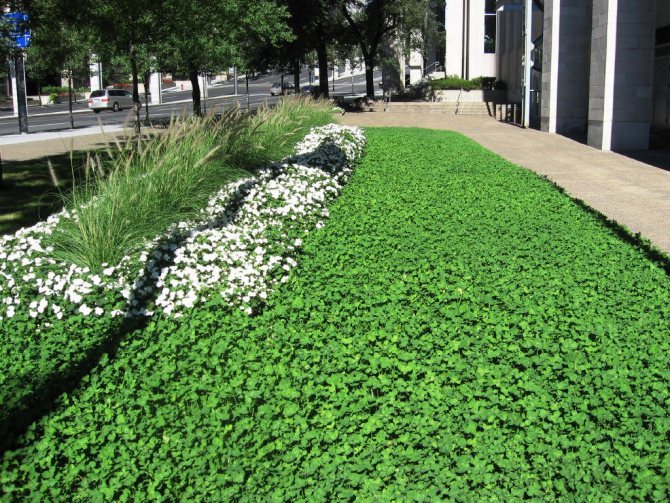

Clover lawn in landscape design
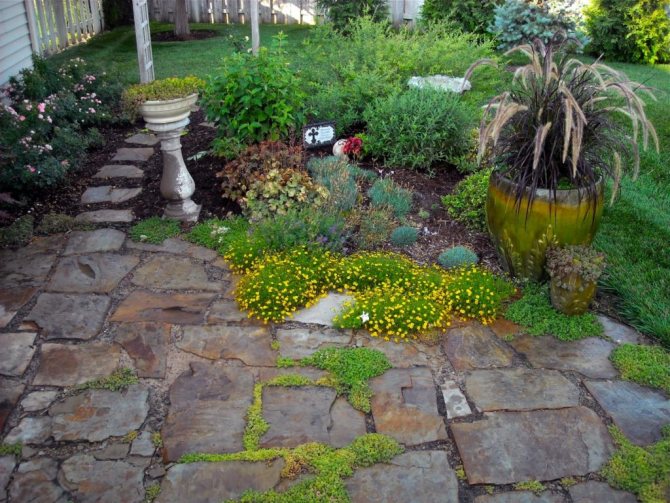

Clover between the slabs
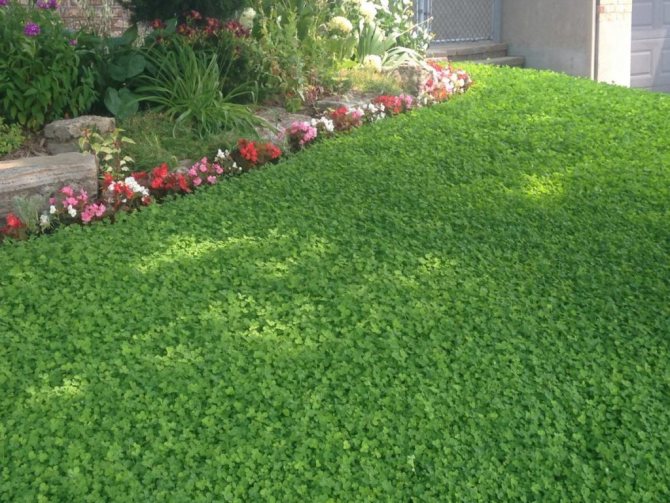

Clover lawn landscape
Where to buy and how much do white clover seeds cost?
If your choice fell on the "green carpet" of white clover, then you can buy seeds at any gardening store.
A photo of the expected result can be seen on the box.
The Rivendel variety is well suited for sowing.
You can take seeds from friends who have this plant on their site. But these seeds are usually weakened and may not bring the expected results.
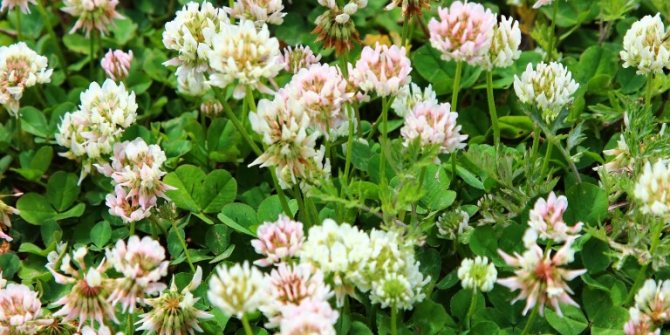

Packing price ranges from 650 rubles per 1 kg... Planting a lawn made of creeping white clover is much cheaper than a classic lawn made of lawn mixtures.
Main types
About 20 varieties are used in landscape design. They differ in height, color and decorative value. Used to create flowering carpet on lawns and lawns. Looks good among the stones of the alpine slide and rockery.
To avoid disappointment, you need to know in detail about the variety that you are going to purchase.
Meadow clover
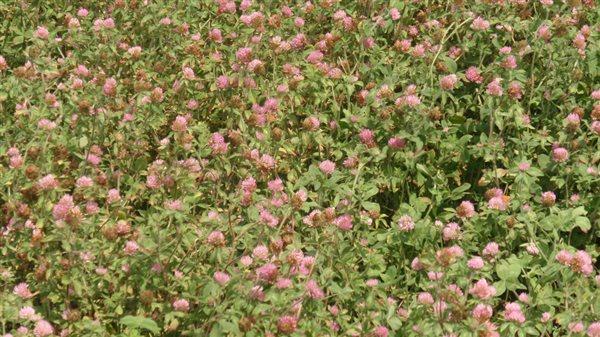

Common wild species. The flowers are pink or reddish. It spreads over meadows, fields, mountains. Unpretentious and tenacious.
White clover (creeping)
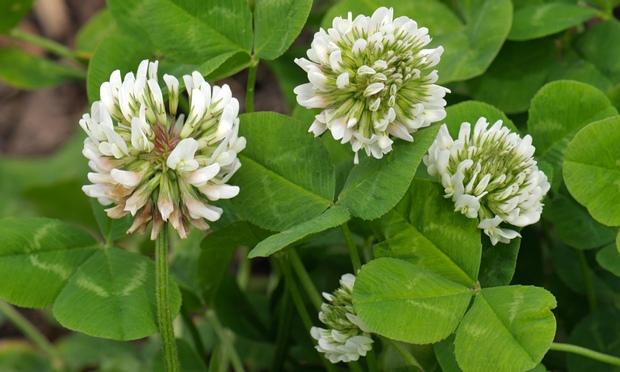

The perennial plant belongs to the creeping species. It spreads along the ground, the length of the stem is up to 40 cm. The leaves are round, triple.It tolerates trampling, frost, drought. It blooms with white balls. The white clover lawn rises 10 cm from the ground, but in the wild can grow up to 30.
Atropurpurea cultivar
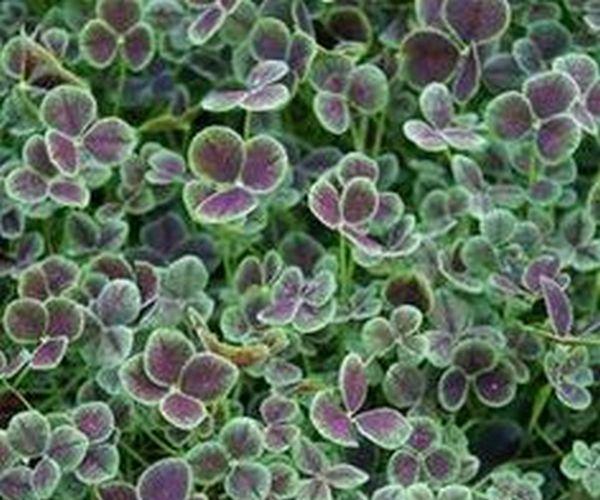

Artificially bred decorative look. Leaves are dark purple in color. The edge is as if outlined with a green pencil. Loves sunny places. It is under the influence of bright light that it acquires its color. In the shade, it will turn green and lose its originality. Leaves from three and four plates.
Purpurascens cultivar
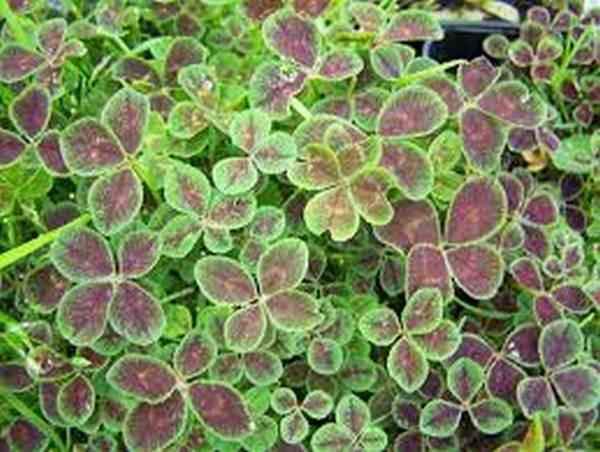

Designed for decorative flower beds. Four-leafed. A brownish-red paint seemed to spread on each leaf, leaving the edges and veins juicy green. Quickly captures the entire surrounding area.
Good Luck variety
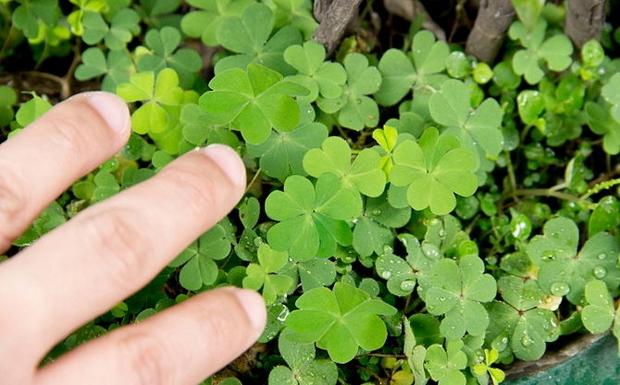

Interesting in color of four leaves. In the center there is a brown spot with jagged edges and light brown veins. Most of the leaf is green with light green veins.
Pink clover
It blooms with pink-white balls. Surpass the meadow variety in vitality. Unpretentious to the increased acidity of the soil. Loves moisture. The period of active flowering is from early summer to autumn. Three leaves are collected on the stem.
Red clover
This is a bush up to 60 cm tall. Inflorescences are elongated, large, crimson-red. The leaves are large, three-toed. Begins to bloom for a long time from the beginning of July. Better spread by seed. When you try to divide the bush, a fifth takes root. The wild species is protected by law.
Bloom
Lawn clover reveals its beauty in the second year. Fluffy pom-poms will appear in close-knit rows from the end of spring and all summer. Then, it is recommended to cut the first wave. September, October the second flowering wave will begin.
Why is it worth decorating the plot with cute lambs?
The main advantage is the beauty and freshness of the soft carpet. But there are also pluses:
- the fertility of the soil increases; it is saturated with nitrogen;
- proximity to a crop strengthens the resistance of neighboring plants to diseases; especially beneficial for cereals;
- bright juicy greens are pleasing to the eye until late autumn;
- lawn maintenance costs are minimal;
- quickly restores a dense and dense cover after mowing;
- resistant to trampling;
- performs well where ordinary lawn grass does not grow;
- the cut shamrock is perfect as mulch.
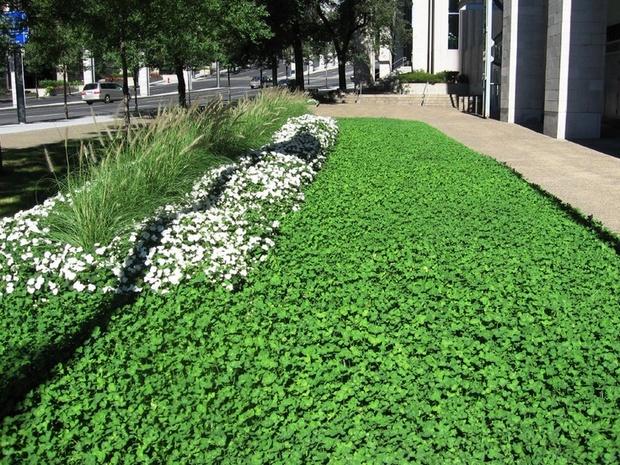

Related Videos
On the pros and cons of a white clover lawn in the video:
White creeping clover is a wonderful ornamental plant that, moreover, has fodder properties. The main disadvantage of the plant - the active attraction of bees - is easy to fight: it is enough to remove flowers in a timely manner by mowing. Therefore, it can be argued that the advantages of clover are superior in importance to its disadvantages.
Shamrock lawns are quite popular today. A perennial plant of the legume family, with original emerald leaves and small spherical flowers, it looks very gentle and cute, and you just want to sow it halfway. In addition, it does not need to be additionally planted and sown all the time, like other grass: thanks to creeping rooting shoots, the plant grows on its own and quickly fills the bald patches on the lawn.
White clover loves loamy and sandy loam soils, neutral or slightly acidic, and does not need abundant watering. Moreover, shading and excessive moisture can be disastrous for her. Flowers on a plant usually appear in the second year, but the lawn will bloom with dwarf fluffy flowers twice a season: from May to August, the first wave of abundant flowering is observed (after which the lawn needs to be mowed), and from August to October - the second.
Which clover is best for the lawn
Which clover is better, white or red, which varieties are suitable for the lawn and which are not…. Agronomical scientists have long answered these questions. About 70 species of trefoil grow on the territory of the countries of the former Soviet Union. Of these, only undersized white clover is used to create a lawn, other varieties are not suitable.Unlike pink or red, after mowing a white clover, there will be no ugly naked clover stems left behind.
How to plant a white clover lawn
In the vicinity of Moscow and other regions with a not very mild climate, it is necessary to sow white clover on the lawn no later than the third decade of August - so that the plant has time to root well before the onset of cold weather. For the lawn, you can use the seed of one shamrock or a mixture of it with other plants, with cereals, etc. However, such a "carpet" must be especially looked after: so that the trefoil does not drown out other plants, their growth is stimulated with mineral dressings. Low clover goes well with both individual shrubs and trees, and with brightly colored flowers, red poppies, lupins, etc. When forming flower arrangements, clover should be planted in separate groups, isolated from other plants. The best answer to the question of how to plant white clover is the lawn of a member of our portal.
Low-growing lawn clover: the pros
White clover lawn is good for those who want to free themselves from careful lawn maintenance. The plant is less moisture-loving than fescue or bluegrass; it is recommended to plant it in lighted places where ordinary lawn grass does not grow well. The shamrock has a high resistance to trampling, and therefore the "white-foam curly carpet" can be used as a lawn for children to play.
In addition to being highly decorative, white lawn clover has a number of other advantages:
- it is enough to plant once, and it forms a dense and long-lasting lawn, which quickly recovers after mowing, but it is better to cut it not with a lawn mower, but with a trimmer;
- keeps fresh healthy greens until late autumn;
- increases the resistance of other plants, especially cereals (ryegrass) to various diseases;
- resistant to weeds, therefore - the most necessary option for those who do not like weeding;
- you can grow such a lawn without significant costs for its maintenance;
- thanks to root tubers containing bacteria, clover as a lawn grass increases the fertility of the soil on the site, enriching it with nitrogen.
Clover lawn does not tolerate nitrogen fertilization. Be careful when purchasing complex fertilizers containing elements of the nitrogen group (ammonium chloride and nitrate, sodium nitrate, calcium nitrate): they can be detrimental to the culture, causing an overdose of nitrogen. Better occasionally, no more than once every two months, to use potassium-phosphorus fertilizing.
Shamrock lawns are quite popular today. A perennial plant of the legume family, with original emerald leaves and small spherical flowers, it looks very gentle and cute, and you just want to sow it halfway. In addition, it does not need to be additionally planted and sown all the time, like other grass: thanks to creeping rooting shoots, the plant grows on its own and quickly fills the bald patches on the lawn.
White clover loves loamy and sandy loamy soils, neutral or slightly acidic, and does not need abundant watering. Moreover, shading and excessive moisture can be disastrous for her. Flowers on a plant usually appear in the second year, but the lawn will bloom with dwarf fluffy flowers twice a season: from May to August, the first wave of abundant flowering is observed (after which the lawn needs to be mowed), and from August to October - the second.


White clover for the lawn. Photo by FRUMHOUSE.
Which clover is best for the lawn
Which clover is better, white or red, which varieties are suitable for the lawn and which are not…. Agronomical scientists have long answered these questions. About 70 species of trefoil grow on the territory of the countries of the former Soviet Union. Of these, only undersized white clover is used to create a lawn, other varieties are not suitable. Unlike pink or red, after mowing a white clover, there will be no ugly naked clover stems left behind.
How to plant a white clover lawn
In the vicinity of Moscow and other regions with a not very mild climate, it is necessary to sow white clover on the lawn no later than the third decade of August - so that the plant has time to root well before the onset of cold weather. For the lawn, you can use the seed of one shamrock or a mixture of it with other plants, with cereals, etc. However, such a "carpet" must be especially looked after: so that the trefoil does not drown out other plants, their growth is stimulated with mineral dressings.
Low clover goes well with both individual shrubs and trees, and with brightly colored flowers, red poppies, lupins, etc. When forming flower arrangements, clover should be planted in separate groups, isolated from other plants. The best answer to the question of how to plant white clover is the lawn of a member of our portal.
Low-growing lawn clover: reasons "FOR"
White clover lawn is good for those who want to free themselves from careful lawn maintenance. The plant is less moisture-loving than fescue or bluegrass; it is recommended to plant it in lighted places where ordinary lawn grass does not grow well. The shamrock has a high resistance to trampling, and therefore the "white-foam curly carpet" can be used as a lawn for children to play.
White clover, lawn. Photo by Forumhouse.
In addition to being highly decorative, white lawn clover has a number of other advantages:
- it is enough to plant once, and it forms a dense and long-lasting lawn, which quickly recovers after mowing, but it is better to cut it not with a lawn mower, but with a trimmer;
- keeps fresh healthy greens until late autumn;
- increases the resistance of other plants, especially cereals (ryegrass) to various diseases;
- resistant to weeds, therefore - the most necessary option for those who do not like weeding;
- you can grow such a lawn without significant costs for its maintenance;
- thanks to root tubers containing bacteria, clover as a lawn grass increases the fertility of the soil on the site, enriching it with nitrogen.
Clover lawn does not tolerate nitrogen fertilization. Be careful when purchasing complex fertilizers containing elements of the nitrogen group (ammonium chloride and nitrate, sodium nitrate, calcium nitrate): they can be detrimental to the culture, causing an overdose of nitrogen. Better occasionally, no more than once every two months, to use potassium-phosphorus fertilizing.
Clover white undersized for lawn: arguments against
As Sodmaster notes, all summer residents are divided into those who want to sow the shamrock, and those who dream of getting rid of it. If you want to plant a living white carpet, and you even bought grass with clover for your lawn, think twice - such difficulties may arise:
- to make the lawn pleasing to the eye, you need to remove the fading flower heads in time;
- white lawn clover dries out for a long time after rain; in wet weather, the grass becomes slippery, and therefore it is better not to use it in places of active recreation;
- creeping clover is an aggressive plant: it quickly crawls along the ground to other flower beds, it is easier to grow it than get rid of it;
- there is a belief, even a belief, that the clover lawn is not mowed. But the answer to the question "should I mow the clover" - yes; and since the clover grass is juicy and soft, the mower will have to be cleaned frequently (knives and bottom);
- the plant is susceptible to fungal diseases and freezing;
- root tubers attract wireworms - worm-like larvae of click beetles, causing great harm to garden and field crops;
- clover is a grass champion among honey plants: it attracts bumblebees and bees every day. It is better not to walk barefoot on such a lawn and it is advisable to mow it more often.
To make the white clover lawn look neat, members of the forum recommend cutting it often - about once every two weeks. However, if you are satisfied with the wilder, more "clover" look, you can mow a couple of times per season.The clover is undersized, and the optimal cutting height is 3-4 cm.
When choosing white clover for your lawn, refer to our ranking of lawn grasses. If someone spoils your lawn and you cannot figure out who, send a photo of the object and they will help you. Learn how to properly plant a lawn in the sand.
Lawn features
The lawn with white clover is called "Sloth". Reviews confirm that the plant is added to the mixture to soften the coating. Such a lawn is good for arranging children's lawns with slides, swings, benches and houses.
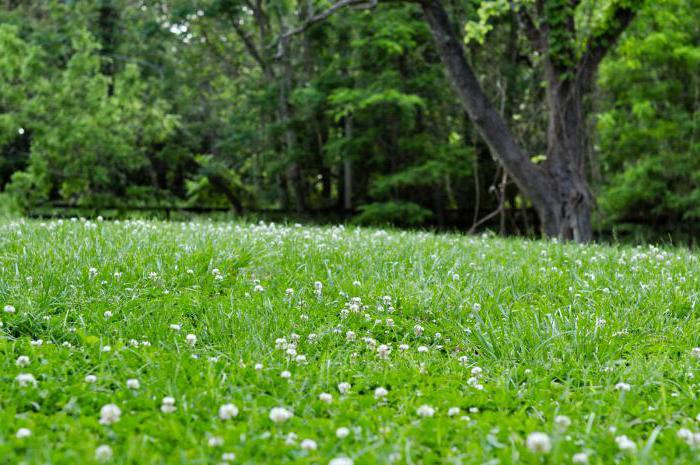

Creeping clover is a stunted plant, so many summer residents do not prefer to cut it. But haircuts are well tolerated by them. The minimum recommended cutting height is 3-4 cm, and the maximum is 10-12 cm.
The nuances of sowing and planting
The site for laying a clover lawn must be dug up, ridding the site of weed roots. Next, the soil is compacted with a roller, the surface is leveled. The nuances of the organization of sowing work also include pre-sowing watering of the soil. For even sowing, it is recommended to mix the seeds with wet sand or sawdust. The seed is deepened by 0.5-1 cm, depending on the looseness of the soil, using a rake. It is also allowed to lightly sprinkle the seeds with sand without covering them with a rake.
Sowing times for low-growing lawn creeping clover vary:
- in early spring, when the remnants of the snow melt, freezing at night with a thin ice crust, the seeds are sown "on a shard", laying them on the ice. With melted water, the seeds are gradually drawn into the ground;
- with the establishment of the daytime temperature within + 12 ° C, the seeds of lawn clover are sown with a shallow embedment in warm, moist soil;
- autumn sowing is carried out before the first ten days of September to ensure high-quality seedlings and rooting of plantings before frost
The podzimny method of planting clover lawn seeds provides for shoots in early spring. For predictable results, the seed rate is doubled.
When to sow red clover? Is it possible in winter or better in spring?
Sophia Guseva
Try in early spring on the last snow, the seeds will go into the ground with it.
Anatoly
In winter - it is in the snow or something
Olga
Be patient until spring
Elena Orlova
it was possible now (two weeks earlier) and in spring it rises normally, now wait until spring
Clover, popularly called the shamrock, is a perennial plant in the legume family. The plant is presented in the form of three emerald-colored leaves with a small spherical flower. If you adhere to the correct technology for planting it, as well as take care of it later, then a blooming lawn will delight you every year with an even and soft carpet. To do everything right, consider the detailed instructions: how to plant white clover for the lawn? Simple tips and some nuances from specialists will allow you to get a green carpet as a result of the work done.

